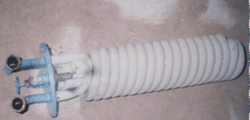There are so many possible combinations of heating, I couldn't really find my combination so I decided to start a new thread. here is the deal: I have a weil mclain 100,000 btu boiler with three zones set up. one for the upstairs, one for the down stairs, and one for the 41 gallon boilermate. All of this is located centrally downstairs and the main living area is upstairs. the house is about 2800 square feet with half upstairs and half downstairs. I also have a wood stove downstairs. without the wood stove burning, I hear the boiler kick on and off constantly all day. With the wood stove burning the house stays well above the kick on temperature for the boiler, but I assume it is trying to keep that 41 gallons of water in the boilermate warm. if I leave the boilermate turned off, I never hear the boiler turn on, and the internal boiler temp drops big time. my first thought was to get rid of the boilermate and put in a toyotomi 0m-148 for my domestic hotwater supply, but then I thought maybe I should get rid of the whole setup and just get a om-180 to act as a hydronic heater as well as for my DHW. I am wondering if the toyo can keep up with my heating needs. does anyone have any thoughts on any of this?
Thanks for any and all info!
Thanks for any and all info!


 The toyotomi is actually a oil fired on demand hot water heater. The boiler mate does seem to lose a lot of heat. It is always pretty warm to the touch. I thought about insulating it, and have read some forums about using Phosphoric acid nickel safe ice machine cleaner to clean out the coil, and that seems to have improved the efficiency for some people. I was thinking about just replacing the boiler mate with the toyotomi om-148 on demand water heater just for the domestic side as I have one that provides hot water for my wife's small restaurant and that seems to keep up just fine using a minimal amount of heating fuel. but then I noticed the bigger unit that is supposed to work for hydronic heating as well as supplying domestic hot water. so I thought for a couple hundred bucks more, why not just replace the whole thing. And when the wood stove is operational the hydronic system almost never cycles. I don't know if the om-180 is a newer unit, but there doesn't seem to be a lot of info out there. I had thought of talking to a dealer, but they kind like to sell things, and I was hoping to get a more unbiased opinion before I talked to a dealer. I am also wondering if anyone knows how many square feet a toyotomi might be able to handle. the house is about 2800 square feet. the weil mclain I have is rated at 100,000 btu and the om-180 is rated at 148,000 btu so I thought it might do the trick, but I am no expert, just a motivated do it yourselfer.
The toyotomi is actually a oil fired on demand hot water heater. The boiler mate does seem to lose a lot of heat. It is always pretty warm to the touch. I thought about insulating it, and have read some forums about using Phosphoric acid nickel safe ice machine cleaner to clean out the coil, and that seems to have improved the efficiency for some people. I was thinking about just replacing the boiler mate with the toyotomi om-148 on demand water heater just for the domestic side as I have one that provides hot water for my wife's small restaurant and that seems to keep up just fine using a minimal amount of heating fuel. but then I noticed the bigger unit that is supposed to work for hydronic heating as well as supplying domestic hot water. so I thought for a couple hundred bucks more, why not just replace the whole thing. And when the wood stove is operational the hydronic system almost never cycles. I don't know if the om-180 is a newer unit, but there doesn't seem to be a lot of info out there. I had thought of talking to a dealer, but they kind like to sell things, and I was hoping to get a more unbiased opinion before I talked to a dealer. I am also wondering if anyone knows how many square feet a toyotomi might be able to handle. the house is about 2800 square feet. the weil mclain I have is rated at 100,000 btu and the om-180 is rated at 148,000 btu so I thought it might do the trick, but I am no expert, just a motivated do it yourselfer.